
Fronds of Trachycarpus wagnerianus after an extended freeze
Things are not looking good in the garden. After several days of temperatures well below freezing, I was hoping for a bit of a thaw this weekend but after an initially promising forecast on Friday was revised downward, and my thermometer read only 30 degrees at 4:00 pm yesterday, I think that's as good as it's going to get. The latest forecast for today is 30 degrees, and 39 degrees tomorrow, but I'll believe it when I see it. Monday will mark a full week of temperatures below freezing.
My dwarf windmill palm (Trachycarpus wagnerianus) was hit hard by an overnight low of 5 degrees in early January, which was exacerbated by high winds. I expected damage to all my palms but T. fortunei "Nainital" and T. fortunei "Bulgarian" recovered very nicely with little apparent damage. That earlier cold snap was for a very short period: only 2 truly cold nights and one day below freezing in between, with warm weather immediately before and after. This second cold wave is another thing entirely. Although the overnight lows haven't been quite as cold--generally low teens or high single digits--we have had several such nights in a row and several days with highs remaining well below freezing.
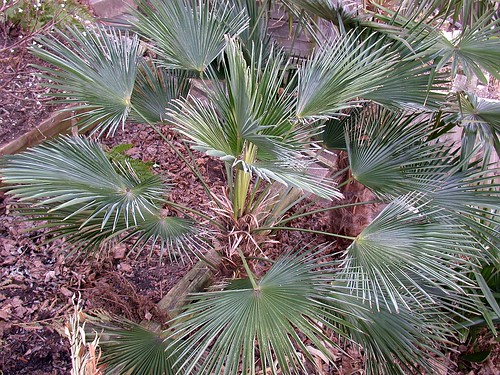
Trachycarpus wagnerianus showing freeze damage about 2 weeks after a low of 5 degrees (but before the second cold wave)
All of my windmill palms now have that freeze-dried look and I'm no longer so optimistic about their survival this spring. They may still surprise me, and spring back when it finally goes above freezing. What I have to keep reminding myself is that windmill palms can suffer massive damage and still recover, although they may not put out any new growth until early summer and may take a full growing season to regain a crown of green leaves. Even after a more "normal" winter windmill palms can look pretty rough and ugly by spring, which will always limit their use in public plantings in areas where they're marginally hardy.
I committed myself several years ago to growing hardy palms without any protection, because I want to document their progress in a marginal zone and find out how hardy they really are. I've always said that windmill palms are marginal in the Washington, DC area and are living on borrowed time. That doesn't mean they're not worth growing, but people who grow them need to have realistic expectations and there is nothing to be gained by telling people that these palms are hardier than they really are. In some winters, like this one, growers should expect to either protect their palms or lose them.
Cold air temperatures and wind aren't the only things that can damage hardy palms. After an extended freeze like this one, the ground can freeze deeply and kill roots that would otherwise help cold-damaged plants to recover in the spring. The one saving grace of this latest cold spell is that we got a few inches of snow immediately before the temperatures dropped, which I'm hoping will provide some extra insulation in addition to the mulch I applied last fall. Other plants like Schefflera delavayi, various begonias, and other perennials are hidden under the snow, and I guess I'll find out in a few weeks whether the ground froze deeply enough to kill tubers and rhizomes that might otherwise survive the winter.
Here are some more photos from around my garden taken on Saturday, when temperatures were still in the low 20's:
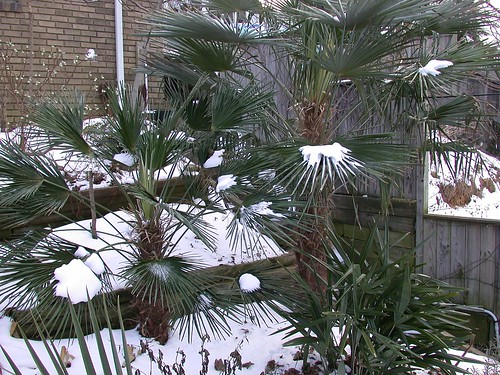
Trachycarpus wagnerianus (left), T. fortunei "Nainital" (upper right), Rhapidophyllum hystrix (lower right). I had high hopes for "Nainital", which was looking great before the current extended freeze.
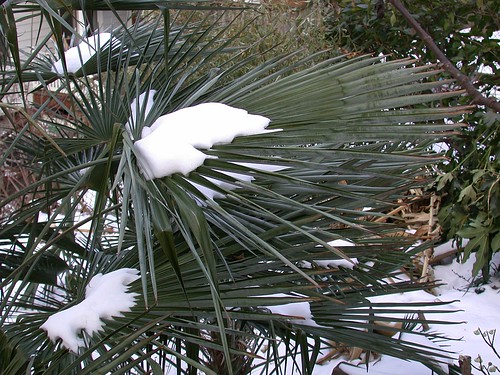
Fronds of Trachycarpus fortunei "Nainital"

Trachycarpus fortunei "Bulgarian". This is supposed to be a hardy strain of windmill palm, and came through a low of 5 degrees with little damage, but the latest extended freeze is taking its toll. Note the silvery, curled leaflets in this and the following photo.
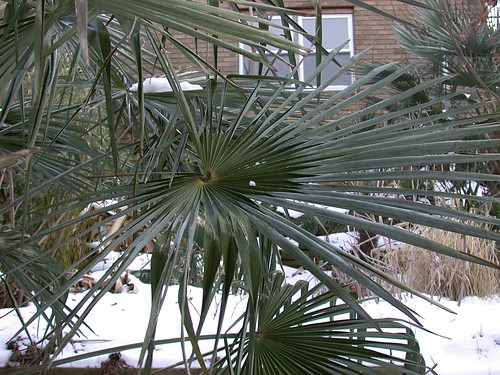
Curled leaflets of Trachycarpus fortunei "Bulgarian"
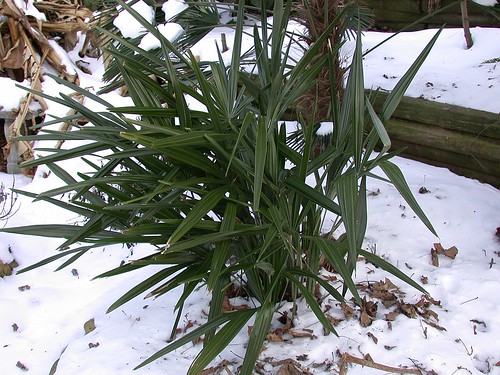
Needle palm, Rhapidophyllum hystrix. Even at temperatures still below freezing, it looks good.

Dwarf palmetto (Sabal minor "McCurtain") and hardy clumping bamboo, Fargesia robusta. The bamboo may partially defoliate, but I won't know until warmer weather. The dwarf palmetto seems mostly untouched except for mechanical (wind) damage.
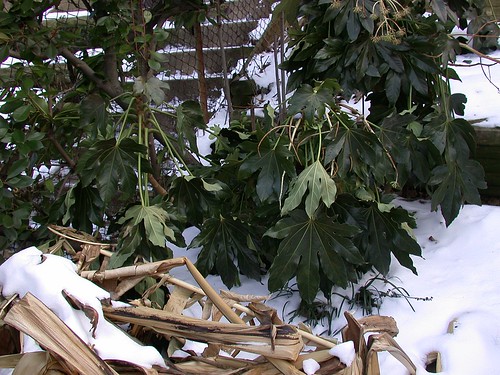
Fatsia japonica doing the usual "fatsia flop". I expect some minor damage, but these should otherwise be okay.
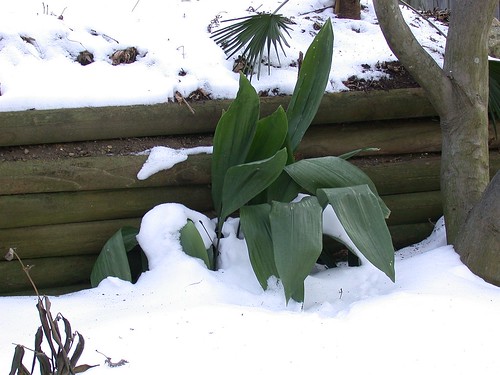
Aspidistra elatior seems untouched. The primary problem I've had with this plant is that the leaves tend to bleach out in late winter when the sun is stronger and higher in the sky, and overhead deciduous trees haven't leafed out yet.
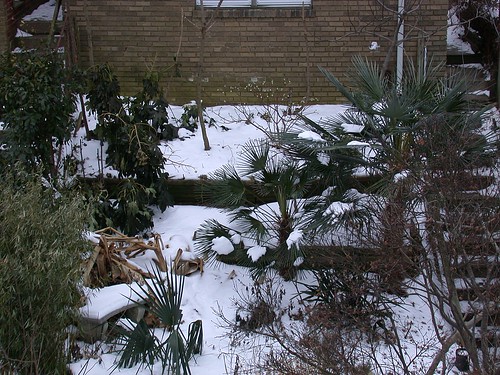
Overview of the garden in winter. Compare to the same view last summer:
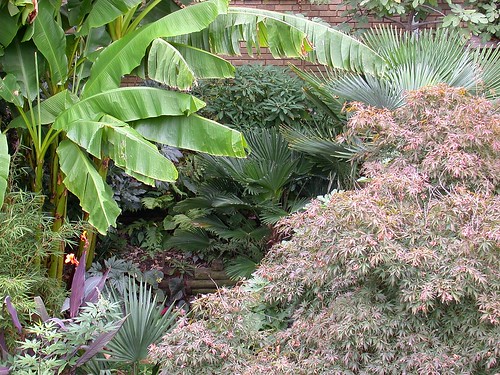
The garden in happier times, October 2013

Great documentation, John. My needles and sabal minors still look okay. Good luck with your Windmills..
ReplyDeleteHope the palms bounce back quickly once spring and warm weather arrives. At least needle palm and sabal still looks good. The problem we have with growing sabals here is that it needs reliably warm summer which we rarely get here.
ReplyDeleteWell damn, I am sorry. I know the game of growing things that are on the borderline. While we know they might perish we still become attached (or at least I do). I hope you'll have some surprises come spring.
ReplyDeleteGood luck, John! After viewing all the damage in my garden, I think I'll return to gardening in pots. Of course, I'll need a bigger greenhouse if that's the case. Anyway, fingers crossed! Best, Paul.
ReplyDelete